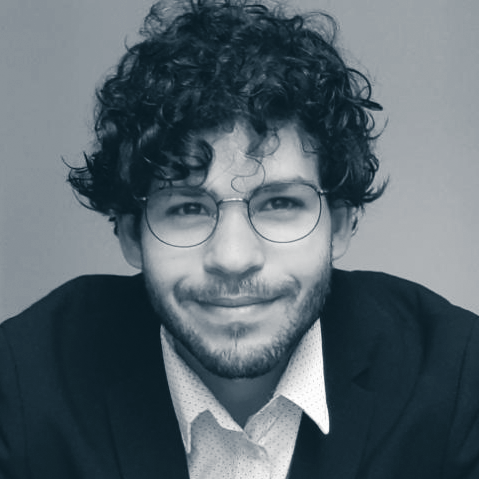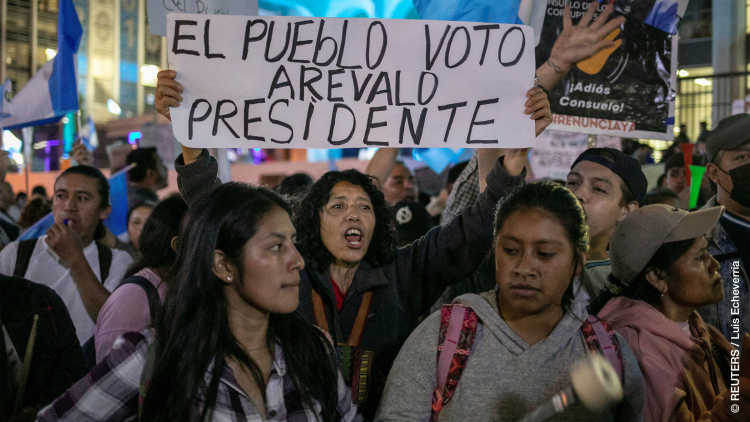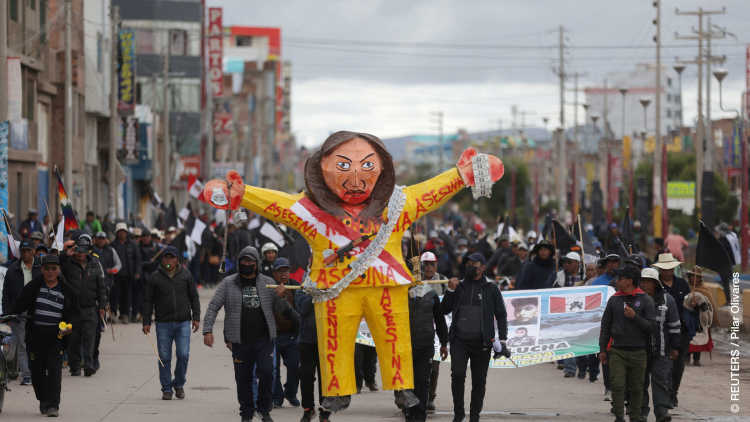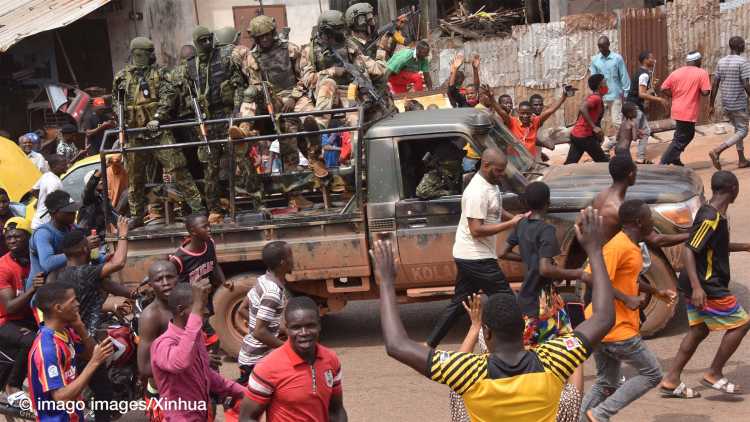- Home
- Publications
- GIGA Focus
- Ballots over Streets: Bolivia’s Fragile Democratic Gamble
GIGA Focus Latin America
Ballots over Streets: Bolivia’s Fragile Democratic Gamble
Number 4 | 2025 | ISSN: 1862-3573

On 19 October 2025, Bolivia will hold a presidential runoff election for the first time in its history. After two decades of one-party dominance, voters turned to two opposition candidates promoting market-oriented reforms. Amid economic strain, Bolivians are channelling their discontent at the ballot box, even as governability remains uncertain.
Bolivia is entering the runoff amid a crisis of representation rooted in weak parties and eroding trust in institutions. This is interacting with a further crisis: economic fragility in the form of stagnation, shrinking reserves, fuel shortages, and dependence on extractive sectors. Those working precariously and in the informal sector are hit the hardest.
Satisfaction with democracy has sunk to a new low, yet Bolivians have channelled discontent electorally rather than in the streets. Protest votes surged in the first round despite both contenders offering only vague or short-term plans, which has raised doubts about their ability to confront structural challenges.
The Legislative Assembly will be decisive for governability. As the most representative body, it can diffuse responsibility and lend legitimacy to unpopular reforms. Yet, neither of the candidates will have a parliamentary majority of his own. Weak parties, fragile coalitions, and politicised courts put it at risk for gridlock.
The next government must rebuild legitimacy by forging coalitions, restoring institutional trust, and balancing urgent economic measures with social protection to avoid renewed conflict.
Policy Implications
To rebuild trust in democracy, the new government must act swiftly to stabilise the economy while protecting the most vulnerable among its population. International partners, especially Germany and the EU, should engage as reliable allies, supporting economic diversification, clean energy, and inclusive growth in line with Bolivia’s own priorities.
Grievances at the Ballot Box: Bolivia’s Political Reconfiguration
In the midst of a deep economic downturn and political uncertainty, on 17 August 2025 Bolivian citizens went to the ballot boxes to elect a president, vice-president, and Plurinational Legislative Assembly. For the first time since the current constitution of the Plurinational State of Bolivia was passed in 2009, which requires a candidate to obtain an absolute majority to become president in the first round, no party or alliance obtained enough votes to win outright. As a result, Bolivia will hold a historical presidential runoff election on 19 October.
The election marks a watershed. In the decades since Evo Morales was first elected president in 2005, his party, the Movimiento al Socialismo (Movement Torwards Socialism, MAS), had been the dominant force in Bolivian politics. In the last election in 2020, which brought current president Luis Arce to power, the party secured 55.1 per cent of the valid votes. Yet, in the August 2025 election, neither the MAS nor Alianza Popular (Popular Alliance, AP) – led by the sitting president of the Chamber of Senators, also from the MAS – reached the runoff: they obtained only 3.7 per cent and 8.5 per cent of the valid vote share, respectively. Instead, it is two candidates from the right of the political spectrum – Rodrigo Paz of the Partido Demócrata Cristiano (Christian Democratic Party, PDC), with 32.06 per cent, and Jorge “Tuto” Quiroga of Alianza Libertad y Democracia (Liberty and Democracy Alliance, LIBRE), with 26.7 per cent – who will face each other in the presidential runoff.
What is striking is the absence of a strong left presence in this election. The tensions between Evo Morales and Luis Arce left the MAS divided. President Arce and the MAS sectors loyal to him put forward young former minister of government Eduardo del Castillo as their candidate, but his campaign was undermined by the low popularity of the president. Meanwhile, another MAS heavyweight, Andrónico Rodríguez, the current president of the Senate, broke with traditional MAS ranks to lead Alianza Popular. Rodríguez has often been cast as Evo’s political heir, but after announcing his decision to run for president, Evo Morales branded him a traitor. He consequentially faced strong backlash from Morales’s supporters, who saw his candidacy as a betrayal of their leader, while at the same time his adversaries bashed him for being the natural continuation of the former president.
Perhaps the most notable omission was Evo Morales himself. Despite his continued influence, he was declared ineligible to run by the Plurinational Constitutional Court. Unable to be a candidate, Morales questioned the legitimacy of the election and called on his supporters to cast null votes. Morales’s campaign proved partially effective: in several municipalities that had long been MAS strongholds, the null vote obtained the largest share of ballots cast. Historically, null voting in Bolivia has hovered around 4 or 5 per cent. However, in this election, it surged to 19.78 per cent – while considerable, still a far cry from Evo Morales’s once overwhelming electoral support.
Before shifting to the strategy of casting null votes, Morales had sought to mobilise his allied social movements in the streets. However, the demonstrations failed to reach the scale he expected. Across Latin America, null-vote campaigns are not unusual; around one quarter of presidential contests since the 1980s have seen efforts to mobilise invalid ballots (Cohen 2024). It is important to stress that spoiling a ballot is not a rejection of democracy itself. Rather, invalid voting usually signals dissatisfaction with the candidates on offer and allows habitual voters a low-cost means of protest (Cohen 2024). Morales’s mobilisation of the null vote was thus less a threat to democracy than a forceful reminder of his social base’s discontent with the options presented.
Democracy under Pressure: The 2025 Electorate
It is striking that Bolivians chose to process their discontent at the ballot box, whether by supporting opposition candidates or deliberately annulling their vote. One would hardly expect such high levels of participation in a context where legitimacy indicators are at historic lows and street mobilisation has a long tradition.
The 2023 AmericasBarometer, the most respected public opinion data on democracy and governance across the continent, shows that in Bolivia satisfaction with democracy has collapsed to 28.2 per cent, the lowest in two decades (Center for Global Democracy 2023). Moreover, just over half of the citizens continue to see democracy as preferable to any other system. Trust in the three branches of government is fragile: 67.4 per cent express little or no trust in the national government, only 31 per cent trust the Plurinational Assembly, and just 21.4 per cent trust the justice system. Confidence in the electoral authority has also eroded to below 30 per cent. Trust in broader institutions fares no better, as fewer than one in five Bolivians trust the police or believe the courts guarantee a fair trial (Moreno Morales 2024).
This crisis of confidence these data reflect raises the question of how Bolivians understand democracy today. Results from the 2024 World Values Survey paint a more nuanced picture. Nearly four out of five Bolivians emphasise elections and voting as crucial for democracy, but only one third link it to institutional safeguards against authoritarianism, and one quarter to redistribution and welfare. These patterns show that voting retains legitimacy even amid distrust, helping explain high turnout and the use of null ballots. However, the patterns also reveal scepticism about democracy’s capacity to protect rights and produce substantive outcomes, signalling limited expectations of what the system can deliver (Osorio Michel forthcoming). This points to a central challenge for the government that will result from the 19 October elections: it will need to rebuild institutional trust while producing concrete results that address the widespread discontent.
Citizens judge democracy not just by procedures but by whether governments deliver effective results (Norris 2011). In Bolivia this is evident: even before the crisis fully unfolded, only 21 per cent approved of Luis Arce’s performance, with negative perceptions of the executive spilling over into assessments of the system itself (Moreno Morales 2024). Bolivians went into the 2025 election with high levels of economic anxiety. Already by 2023 and 2024, when the downturn had not yet reached its present levels, citizens were pessimistic about both the national economy and their personal finances. According to the AmericasBarometer, the share of Bolivians rating the national economy as “bad” or “very bad” rose from around 39.2 per cent in 2021 to more than 73.7 per cent in 2023. Moreover, 41.9 per cent of respondents reported that their household income had decreased in the two years prior to the survey, and one third said they had run out of food in the previous three months due to lack of money or resources. These perceptions correlated strongly with core democratic attitudes. Bolivians who described the economy as “very bad” consistently reported lower satisfaction with democracy, weaker trust in political institutions, and diminished confidence in the democratic regime.
It is telling that the 2025 election was shaped by a volatile electorate, one that made decisions late and without strong conviction. A majority of Bolivians reported deciding their vote only two weeks before election day, and nearly one third chose on the very same day (Ipsos Ciesmori 2025). This was especially evident among supporters of the frontrunners: half of those who backed Rodrigo Paz decided in the final week, and 41 per cent of Tuto Quiroga’s voters did likewise.
At the same time, economic hardship played a decisive role in fuelling protest through the invalid vote. Among those who cast a null ballot, 55 per cent said they were struggling to make ends meet at the end of the month – ten points higher than among voters who supported the candidates advancing to the runoff. This suggests that protest voting was not simply an abstract rejection of the candidates on offer but is linked to material insecurity and dissatisfaction with the system’s ability to respond to everyday needs.
The Tasks Ahead: The Economic Crisis
The most pressing challenge for the next government will be the economic crisis, which lies at the heart of current discontent. Even after the first-round vote, most citizens remained pessimistic: in a September survey, 43 per cent expected the economy to worsen and 31 per cent foresaw no change (Friedrich-Ebert-Stiftung 2025). This reflects years of stagnation, high inflation, and doubts about the state’s capacity to provide stability. From day one, the next government will face pressures on prices, fiscal sustainability, and growth.
Bolivia is caught in stagflation, a combination of minimal growth and persistent, high inflation. GDP grew only 0.7 per cent in 2024 while inflation reached nearly 10 per cent, with cumulative inflation already above 15 per cent in mid-2025. This scenario makes economic policymaking particularly difficult because measures to stimulate growth often risk driving inflation, while efforts to curb inflation can further depress economic activity.
Behind this dilemma lies a decade-long fiscal deficit. Since 1986, governments had maintained fuel subsidies by covering the gap between domestic and international prices. During the commodity boom, abundant gas income made this policy viable. Once gas revenues began to decline in 2014, it became unsustainable. Rather than phasing out subsidies, MAS administrations financed them with public debt, Central Bank reserves, and even pension funds from the state agency Gestora, shrinking net international reserves from USD 15.1 billion in 2014 to under USD 2 billion in 2024. Addressing these imbalances will be unavoidable for the incoming administration, but any reform carries high political risks.
As a consequence, the government has struggled to secure hard currency both to import fuel and to sustain the long-standing fixed exchange-rate policy (around BOB 6.97 per USD). Bolivia now imports 56 per cent of its gasoline and 86 per cent of its diesel, making shortages especially acute over the past year: long queues for diesel slowed transport and logistics, and farmers in Santa Cruz warned the crisis could derail the harvest. With one third of the basic food basket imported, the combination of dollar pressures and fuel disruptions directly hit household economies.
The paradox is that Bolivia experienced its most prosperous years in recent decades on the back of hydrocarbons. Natural gas became Bolivia’s main export, representing nearly half of total sales for two decades, while high mineral prices restored mining as a key pillar of the economy (Agramont-Lechín 2025: 46, 48). Yet, this extractivist model entrenched dependency rather than reducing it. The revenues from the boom years were not channelled into diversifying the productive base, which left the economy exposed to fluctuations in global commodity markets. Moreover, production steadily declined, and no significant new gas fields have been discovered. Output fell from about 56.6 million cubic meters per day in 2016 to just 31.9 million cubic meters per day in 2023 (Reuters 2024). Exploration has largely stagnated, with many highly touted wells proving dry.
In 2024 Bolivia’s exports remained dominated by hydrocarbons and minerals, with agriculture a distant third and heavily concentrated in soybeans for regional and Asian markets (Agramont-Lechín 2025). This reliance on a single crop leaves domestic supply vulnerable: soybeans are mainly processed into cooking oil and livestock feed, making them essential to households and the agrifood chain. Despite export restrictions meant to secure the domestic supply, shortages persist, while producers complain of lost revenues and underinvestment due to limited access to international markets. The Amazon offers potential alternatives in non-timber forest products such as Brazil nuts, coffee, cacao, and açaí, but these are small-scale products that are volatile in yields and heavily dependent on intact forests. That ecological basis is now at risk: 2024 saw the worst wildfire season on record, with 1.26 million hectares burned, and deforestation from ranching and large-scale agriculture has destroyed more than half of the forest lost since 2010 (Czaplicki 2024). For Brazil nuts and açaí, this degradation undermines production just as global demand is rising, leaving Bolivia’s chances for diversification uncertain. Finding a sustainable balance between export dependence, food security, and forest conservation will be a critical test for the next government.
Moreover, around 85 per cent of Bolivian workers are employed in the informal sector, without formal contracts, social security, or pension contributions (INESAD 2023). In a context of stagnation, this majority is particularly vulnerable. Precarious jobs offer little protection against inflation and declining demand, leaving many reliant on insecure, low-productivity livelihoods and exposed to inflation and external shocks. Crafting policies that extend protection to this majority of workers will be among the most difficult tasks facing the new administration.
Weak Institutions, Fragile Rule of Law
If economic challenges are daunting, the institutional obstacles the next government confronts are no less severe. On the one hand, according to V-Dem, Bolivia has experienced an improvement in the electoral dimension of democracy since the 2019 political crisis. As proof, the 2025 first-round elections were conducted successfully and widely praised, producing a competitive runoff between two opposition candidates for the presidency and renewing the Plurinational Legislative Assembly. However, other dimensions are eroding. Bolivia’s Liberal Democracy Index – which captures the extent to which electoral competition is reinforced by the rule of law, judicial independence, and effective checks on executive power – declined again in 2024. This points to a system where ballots are cast and counted fairly, but where the institutional guarantees that sustain democracy remain weak (V-Dem 2025).
Moreover, Freedom House classifies Bolivia as “Partly Free” in its Freedom in the World 2025 report, underscoring persistent institutional weaknesses. Among the most serious problems are the erosion of the separation of powers and the lack of independent access to justice, with courts heavily politicised and vulnerable to pressure from the executive. These deficiencies mean that citizens often face arbitrary decisions and limited remedies when their rights are violated. Reversing this erosion will be essential if the next government is to strengthen accountability and regain public trust.
Corruption compounds these issues. Ahead of the first round of the 2025 elections, 44 per cent of Bolivians identified it as the country’s most pressing problem (Ipsos Ciesmori 2025). Transparency International’s Corruption Perceptions Index 2024 places Bolivia near the bottom of the regional rankings with a score of just 29/100, while the World Justice Project situates it 141st of 142 countries worldwide, underscoring the pervasiveness of corruption. These findings confirm that while electoral democracy shows resilience, the institutional foundations meant to guarantee accountability and rule of law remain fragile. Curbing corruption thus stands out as another unavoidable task for any incoming administration.
Bolivia also faces a crisis of representation, driven above all by the fragility of its party system. According to the 2023 AmericasBarometer, only 13.1 per cent of Bolivians expressed trust in political parties. In fact, parties have been instrumentalised and turned into mere electoral vehicles. This year’s elections are an illustration: Tuto Quiroga was the candidate of the Christian Democratic Party in 2014 – now the same party is fielding his opponent in the runoff, Rodrigo Paz. On the other hand, in 2020 Paz was elected senator for an alliance that included the Revolutionary Left Front (FRI); today, that party is a member of Quiroga’s LIBRE.
It comes as little surprise, then, that the programmatic proposals of the candidates and the ideological bases of the parties that support them have little ideological consistency. Party labels offer voters scant guidance, as elections revolve around the figures at the top of the ticket and reinforce a highly personalistic dynamic. Deputies and senators, often unknown and recruited ad hoc, ride almost entirely on presidential coattails. For Bolivians, representation thus becomes shallow – tied to individual leaders rather than to coherent parties or enduring programmatic visions. This is a weakness the next government will have to navigate if it seeks lasting support.
Can Candidates Handle the Crises?
The outcome took many observers by surprise, as none of the polls had anticipated a victory for the PDC’s Rodrigo Paz. In fact, Paz started the campaign with just 4.3 per cent support in the polls. The electoral results demonstrate that the traditional MAS vote largely migrated to his candidacy. A mix of identity-based elements and widespread fatigue with the other options opened the possibility of connecting with these sectors through the slogan: “Capitalism for all.”
Rodrigo Paz is the son of former president Jaime Paz Zamora. He held five public roles from 2005 to 2025, as deputy, senator, councilman, and mayor of Tarija. Paz was joined by Edman Lara as the vice-presidential candidate. Lara is a former police captain who became nationally known for exposing corruption inside the force. He lacks public experience but has a strong following on social media, especially on Tik Tok. After the first-round victory, Lara was at the centre of controversial statements that hinted at personalist and authoritarian characteristics. While this alarmed some sectors of society, it seems to have reinforced their backing among the existing Paz–Lara supporters.
The written plan presented by Paz–Lara to the electoral institution is ambiguous. They propose a total restructuring of the distribution of state resources, called the “50/50”: half of what is collected would go to the central government, the other half to local governments. Paz’s media campaign launched proposals targeting the most vulnerable social sectors. In August, Lara made verbal proposals outside of this written programme that were unrealistic in the face of the fiscal deficit, such as benefits for senior citizens and single mothers. These proposals have since been incorporated into the platform, but not as a short-term policy.
The other candidate in the runoff is Jorge “Tuto” Quiroga. Quiroga had been Bolivia’s president from 2001 to 2002, after having served as vice-president to Hugo Banzer Suárez, Bolivia’s former dictator who returned to office through democratic elections. The 2025 elections are Quiroga’s third bid for the presidency. Quiroga’s running mate is Juan Pablo Velasco, a young entrepreneur with limited political experience.
Velasco was part of a major controversy after posts apparently made by him between 2010 and 2012 were revealed, containing violent racist statements against people of Indigenous descent from the Bolivian highlands and referring to them using a derogatory term. Two long-established fact-checking organisations verified the authenticity of the account and the posts. In response, Velasco insisted they were false and decried the smear campaign. In this way, he is trying to undermine the credibility of the only two fact-checkers protecting the polarised Bolivian digital ecosystem from disinformation.
The Quiroga–Velasco plan follows traditional liberal lines, featuring fiscal cuts and seeking credits from the International Monetary Fund (IMF) and other international financial organisations. The recipe for economic recovery is based on the reactivation of extractive sectors such as fuel, gas, agroindustry, and mining. Quiroga’s rhetoric identifies a sequence of steps to stabilise the macroeconomy, which are not necessarily realistic in the short term. In his second-round campaign, Quiroga appears much more moderate regarding fiscal adjustment and less inclined towards shock measures, even mentioning tax “pardons” and the maintenance of cash-transfer schemes.
In Bolivia, written government programmes have to be submitted to the electoral institution (Órgano Electoral Plurinacional) as official documents and are the basis around which campaigns should revolve. However, in practice they end up being a mere formality. We have observed that during the electoral contest, other types of proposals were verbally suggested, in a kind of public opinion barometer.
In neither campaign’s programme are the action items for the application of the policies elaborated solidly. Reforms to the Bolivian regulatory framework are discussed mainly in terms of foreign investment. Issues related to education, health, and the environment are relegated from the political discourse and debate. In fact, although the social and environmental impacts of the political proposals are mentioned, they do not represent areas of genuine interest. The extractivist model remains the axis of both programmes’ economic proposals, and both could be considered right-wing options on the political spectrum. In sum, they propose market liberalisation but support some version of a welfare state and social protection through cash-transfer programmes. These ideas would be considered moderately right-wing, although they do not follow a strict ideological line.
The High Stakes of Governability
The next administration will inherit an explosive mix: acute economic stress, eroded institutional trust, and a fragmented party system. This increases the probability of renewed contention, both in the streets and inside the state, especially when parties lack organisational roots and programmatic discipline. With the MAS’s long-standing hegemony broken, Bolivia has entered open-ended coalition presidentialism, where durable governability hinges on the winner’s capacity to negotiate cross-party bargains that can survive unpopular economic decisions.
If subsidy reforms, exchange-rate adjustments, or cuts to transfers are implemented by presidential decree, pressure from the streets could escalate quickly once economic hardship deepens. The legislature, however, can serve as a buffer. The Plurinational Legislative Assembly, as the country’s most representative deliberative body, arguably has broader legitimacy than the executive and offers a forum where socially costly measures can be designed and approved, while ensuring that compensatory policies protect the most vulnerable. Public deliberation in the Assembly diffuses responsibility for unpopular reforms, making it an indispensable arena for governance in times of low trust (Bächtiger et al. 2005).
Whoever wins the presidency will hold only a minority in the Plurinational Assembly. The PDC has 70 of 136 seats (44 per cent of the Chamber of Senators, 54 per cent of the Chamber of Deputies), while LIBRE holds 53 (33 per cent and 41 per cent, respectively). Other opposition forces include Alianza Unidad with 35 seats and Autonomía Para Bolivia – Súmate (Autonomy for Bolivia – Súmate, APB Súmate) with 6. By contrast, Alianza Popular, led by former MAS leader Andrónico Rodríguez, has 8 deputies, and the MAS itself just 2, both without Senate representation. Although this distribution could, in theory, favour governability through opposition cooperation, the weakness of parties and fragile discipline make shifting coalitions and defections constant risks. Any governing agenda will need at least two, and likely three, congressional partners, in a context where party labels offer voters little guidance and legislators often act independently of weak partisan structures, always leaving gridlock on the horizon.
The runoff itself adds to the challenge. When parties are weak and personalised, second-round contests often generate “negative majorities,” where citizens vote more against one candidate than for one. Such outcomes risk compounding distrust if the victor claims a plebiscitary mandate (Pérez-Liñán 2006). This danger is especially acute in Bolivia, where both runoff contenders are drawn from the right and nearly one fifth of voters opted to annul their ballots in protest. The way forward is not to concentrate power in the presidency but to construct a coalition that visibly co-owns the agenda. By front-loading deliberation in the Assembly, sharing authorship of reforms with coalition partners, institutionalising negotiation across levels of government, and clearly communicating the compensatory measures attached to each painful step, the executive can shift contention from the streets into the legislature.
Economic stabilisation will be impossible without political stabilisation. In the initial months, the overriding task will be to transform fragmented electoral backing into a parliamentary coalition strong enough, and collectively accountable enough, to pass a credible and socially protective stabilisation package. Far from being an obstacle, the Assembly is the only available scaffold of legitimacy for a government that must take decisions as unpopular as they are urgent.
A Call to Action for Germany and the EU
Bolivia now stands at a turning point. Past governments turned to powers such as China, Russia, Iran, and India, seeking investment and geopolitical backing. These alliances often brought resources but did little to strengthen democratic institutions or foster inclusive development. As the country transitions to a new government, what Bolivia needs are international partners who value democracy and treat the country as a counterpart on eye level rather than a client.
Germany and the European Union are well positioned to play this role. In the coming months, Bolivia will likely seek new loans or refinancing arrangements, including with European partners. The terms of these agreements can be decisive: rather than reinforcing dependency, they should help stabilise public finances, broaden the productive base, and reinforce social protections. Above all, cooperation must rest on dialogue and shared priorities.
German cooperation has had a decades-long foothold in Bolivia through the GIZ, with projects spanning climate-resilient farming in the Andean valleys, forest protection in the Amazon, and renewable energy integration. Building on this record, collaboration can scale up where it already has credibility on the ground, showing that international partnerships can strengthen community resilience and institutional capacity without imposing external agendas.
With both candidates pledging to safeguard private enterprise and property rights, the new government will also seek to attract foreign investment. This creates an opportunity for German industries. Bolivia has strong potential in the clean-energy sector, from solar to wind to hydropower, as well as in sustainable tourism, where its natural and cultural assets remain underdeveloped. Strategic investment in these sectors would not only generate returns but also help reduce dependence on extractives and create quality jobs.
Footnotes
References
Agramont-Lechín, Diego (ed.) (2025), La Bolivia del futuro, La Paz: Fundación Friedrich Ebert (FES Bolivia).
Bächtiger, André, Markus Spörndli, Marco R. Steenbergen, and Jürg Steiner (2005), The Deliberative Dimensions of Legislatures, in: Acta Politica, 40, 2, 225–238.
Center for Global Democracy (2023), AmericasBarometer: Bolivia 2023, v5.0 [dataset], Nashville: Vanderbilt University.
Cohen, Mollie J. (2024), None of the Above: Protest Voting in Latin American Democracies, Ann Arbor: University of Michigan Press.
Czaplicki, Stasiek (2024), Nuevo informe revela a los principales responsables de la deforestación en Bolivia: ganaderos, menonitas y colonos lideran la destrucción de los bosques, in: Revista Nómadas, 22 October, accessed 14 October 2025.
Friedrich-Ebert-Stiftung (FES Bolivia) (2025), Contexto y escenarios prospectivos 2025: Cuestionario Delphi, tercera ronda y datos comparados (septiembre), La Paz: FES Bolivia.
INESAD (2023), Un 85% de los ocupados en Bolivia forma parte del sector informal, 20 December, accessed 14 October 2025.
Ipsos Ciesmori (2025), Encuesta Electoral Nacional 2025, La Paz: Ipsos Ciesmori, cited in: Unitel, Así Decidimos: Elecciones Presidenciales 2025, accessed 14 October 2025.
Moreno Morales, Daniel Eduardo (ed.) (2024), La democracia en los ojos de la gente: 25 años de cultura política en Bolivia, La Paz: Fundación Konrad Adenauer / Ciudadanía, Comunidad de Estudios Sociales y Acción Pública.
Norris, Pippa (2011), Democratic Deficit: Critical Citizens Revisited, Cambridge: Cambridge University Press.
Osorio Michel, Daniela (forthcoming), “Democracia y valores sociales en Bolivia.” In Encuesta Mundial de Valores en Bolivia 2024, La Paz: United Nations Population Fund / Ciudadanía, Comunidad de Estudios Sociales y Acción Pública.
Pérez-Liñán, Aníbal (2006), Evaluating Presidential Runoff Elections, in: Electoral Studies, 25, 1, 129–146.
Reuters (2024), Bolivia Govt Announces Natural Gas “Mega Field” in Biggest Discovery since 2005, 15 July, accessed 14 October 2025.
V-Dem Institute (2025), Informe sobre la Democracia 2025: La autocratización continúa en medio de conflictos y crisis, Gothenburg: University of Gothenburg, accessed 14 October 2025.
Editor GIGA Focus Latin America
Editorial Department GIGA Focus Latin America
Research Project
Regional Institutes
Research Programmes
How to cite this article
Aparicio, Natalia, and Daniela Osorio Michel (2025), Ballots over Streets: Bolivia’s Fragile Democratic Gamble, GIGA Focus Latin America, 4, Hamburg: German Institute for Global and Area Studies (GIGA), https://doi.org/10.57671/gfla-25042
Imprint
The GIGA Focus is an Open Access publication and can be read on the Internet and downloaded free of charge at www.giga-hamburg.de/en/publications/giga-focus. According to the conditions of the Creative-Commons license Attribution-No Derivative Works 3.0, this publication may be freely duplicated, circulated, and made accessible to the public. The particular conditions include the correct indication of the initial publication as GIGA Focus and no changes in or abbreviation of texts.
The German Institute for Global and Area Studies (GIGA) – Leibniz-Institut für Globale und Regionale Studien in Hamburg publishes the Focus series on Africa, Asia, Latin America, the Middle East and global issues. The GIGA Focus is edited and published by the GIGA. The views and opinions expressed are solely those of the authors and do not necessarily reflect those of the institute. Authors alone are responsible for the content of their articles. GIGA and the authors cannot be held liable for any errors and omissions, or for any consequences arising from the use of the information provided.




















